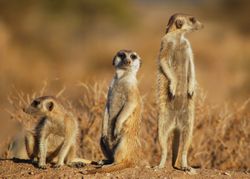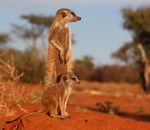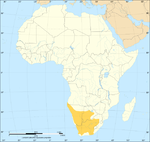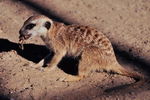Meerkat
| Meerkat |
|---|
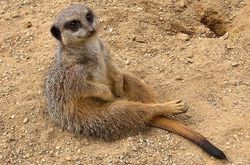
|
| Scientific Classification |
|
| Scientific Name |
|
Suricata suricatta |
Meerkats are a species of mongoose and the only member in the taxonomic genus Suricata. They are native to southern Africa and the Kalahari Desert and live in burrowed holes in the ground. The name meerkat in the South African language, Afrikaans, means Marsh Cat. Which is odd because they do not live in marshy areas and are not cats but was coined in 1776.[2] Meerkats are endangered animals there are over 1 and half a million meerkats in the world and increasing. Meerkats are very intricately designed showing that God cares for all his creations.
Body Design
The meerkats have a special body design and their head has many important features for them to survive in their habitat. The meerkat's have two eyes that are surrounded by dark markings, which acts like sunglasses for the meerkat. Their eyes can also make their eyes appear bigger making themselves look frightening to their predators. They are farsighted and have horizontal pupils ,that give them depth perception, makes them able to be able to spot their prey 0.6 miles out. Although their vision far away is excellent there vision up close is very blurry so they have to rely on their sense of smell. Meerkat's have a narrow nose that only comes to a point of 2-3 inches. Pups are born with bright pink colored noses but as they age the females will remain the same bright pink, while the males will change completely black. The meerkat's sense of smell is very strong it can detect when a predator of if prey is near, and can also tell how long a predator or meerkat rival has been in the area and what animal it was. Meerkat's small round, dark colored, ears are both set low on both sides of their head. Their ears are retractable, they do this when they are looking for termites and do not want to get sand in their ears. Meerkat's are carnivores that have really sharp teeth, for eating through an exoskeleton of insects. Meerkat's have a total of 4 canines, 12 incisors, 12-16 premolars, and about 4-8 molars giving the a total of about 36-40 teeth. They use their fangs for killing and catching prey and also when they are in fights. [3]
Meerkat's are designed with many great abilities that help them strive and survive their many of their predators. Starting with their body length, they can measure up to 9.75 inches to 11.75 inches only from their head to rump. Their tails add another 7.5 inches to 9.5 inches of length. Meerkat's weigh only 2.2 pounds, that's just as much as a squirrel would weigh.[4]. Meerkat's use their tails, that are just as long as their whole body, for other uses for survival. Such as helping them keep their balance while they stand. Which lets meerkat's stand on both their hind feet and use their tail as a third foot to keep its balance in a standing position.[5] Another use for the tail is to show whether the meerkat is either clam and peaceful or if they are alert, waiting for danger, or in a playful behavior. Meerkat's only have four non-retractable claws which gives them a total of 16 claws or weapons and each claw measures up to 2 cm in length. Meerkat's use these claws as digging tools, scratch an enemy in a fight but meerkat's like using their fangs rather than their claws while fighting. While their claws are small their forearms comes with incredible strength and this strength helps them to moves rocks from one place to another. Their legs are also strong and that helps the meerkat stand with only their hind feet and tail. Meerkat's can also run up to 20mph with the extra padding provided on their feet and hands. The fur of a meerkat can either be dark brown, light grey, pale tan, medium brown or bright orange. This fur is a conductor to help meerkat's not sweat but it is as helpful when it is cold at night.[3]
Life Cycle
Female meerkats reach sexual maturity at the age of one and can have 1-7 pups (babies) 4 being the most common number. They can have 4 litters in one year giving them around 16 pups a year alone, but it depends on how much food they can eat. Female meerkats can have up to 70 pups in their lifetime, and they can have these pups anytime in the year. Yet they desire to have their pups in the rainy season so food is very much available. Meerkats have a gestation period of 70 days and after those days they will give birth under ground in a burrowed hole and the pups do not come out of they hole until they are 3 weeks old.[6]. When pups are born the are blind, deaf, and almost completely hairless the mothers keep them in the hole until 3 weeks to help insure that the pups will live. They weigh only 25-36 grams at birth.[7]. Pups ears open after 15 days of birth and their eyes open 10-14 days after birth. Once the meerkats live above ground they are then cared for by their groups babysitter not their mothers. They stay with this babysitter until they are old enough to join the mob at about 4-5 weeks of age. The pups become an adult at the age of one and will start to reproduce continuing this cycle. Until 12-14 years when the meerkats reach the end of their lifespan. [6]
Pups are meerkats under the age of 6 months. Normally pups are born underground and stay there for 3 weeks but some are born in the mob so they are raised by a dominant male and female. Once the pups reach 4 weeks they go on forging trips with their group, and are feed forging out members by calling out in what is called the pups begging call. Which encourages the forging group to hunt and give them food. When they grow older these meerkats are then taught by adult meerkats. They will teach these young meerkats how to handle their prey alive and how to hunt down their prey. Once the pups grow older the pup begging calls lose their meaning and even the adults will ignore them so that the young meerkats learn how to survive on their own by getting their own food.[6]
Ecology
Meerkats are small burrowing animals found throughout southern Africa. [8]While some animals can not live in deserts meerkats were built to live in a harsh environment, such as the desert.[9] They are found in deserts and the grasslands of Africa. This includes southern Botswana, western and southern Namibia, Kalahari Desert, and north and west South Africa. Also can include extreme places such as southwestern areas of Angola and in the lowlands of Lesotho. Meerkats don't live on their own but live in big groups. Sometimes they may live with other meerkat families forming a community that is further called a mob. A mob includes 3-50 meerkats. Mobs, families, communities, and groups all live in multiple intricate holes underground so the meerkats can be able to stay safe from their predators. These tunnels not only provide protection and a place for the meerkat to live but on hot sunny days the ground cools them too. One burrowed hole can have 15 entrances and exit holes and are 6.5 feet deep. Meerkats burrow one too many holes before they will start to live there so they are left with more burrowed holes than needed, so they can move from one burrow to another whenever needed.[10]
A meerkats diet mainly contains of a variety of insect because meerkats are carnivores. Their diet also includes lizards, birds, and fruit. They will also occasionally treat themselves to some scorpion too. Adult meerkats grow to have immunity for venom so scorpions don't bug them but pups are not so their mothers when giving them scorpions will cut off the stinger so there is no room for error.[11] Meerkats go hunting in groups to be protected from their predators. They use the dark splotches around their eyes to reduce to sunlight. Like when a football player has eye black on it is to prevent the sun to go in their eyes. This also helps by letting the meerkat have a better vision to not be hunted on when hunting. And because meerkats have very little fat to storage, they must go hunting everyday.[9] While meerkats are predators to certain animals other animals see meerkat as their prey, like hawks and eagles. They usually go soaring in the sky and then swoop down and snatch their meal. So daily the meerkats will have lookouts to prevent this from happening to themselves. [10]
Threats
Meerkats encounter predatory threats in the sky, ground, and the weather. The sky holds the Martial Eagle, these eagles have a wingspan of six feet. They can easily prey an these helpless meerkats. When the alarm goes off that the bird is in the sky, meerkats go into bolt holes and if there are not any near them they lie on the ground and depend on camouflage. They can and will also take cover behind a thorny bush where birds don't even think of going to. The ground holds jackals and other wild cats that the meerkats are threatened by but can chase away a jackal. Badgers also threaten meerkats, because their burrowing can penetrate the meerkats home making them feel helpless. Not only do the cats scare the meerkats on ground but so do the cobras. Meerkats mob the cobra if it tries to come into their home they even have the ability to kill the cobra.
The weather is another threat to meerkats specifically the summer rains. Newborns are often born during this time so the meerkats must make sure that they are on high ground to avoid flooding in their burrowing system. The alpha female is the one who while take one pup and the next to a safer location, but at night they can get stuck in a flooding burrowing system.[12]
Video
Documentary on the Meerkat in southern Africa.
References
- ↑ Suricata Suricatta Wikispecies. Web. Last Modified January 27, 2016. Author unknown.
- ↑ WhatDoesMeerkatMeanInSouthAfricanLanguage rocketswag.com. Web. Last accessed February 9, 2016. Author unknown.
- ↑ 3.0 3.1 MeerkatAnatomy Meerkats Wiki. Web. Last edited January 27, 2015. Author unknown.
- ↑ Bradford, Alina. MeerkatFacts Live Science Contributor. Web. Published September 29, 2014.
- ↑ Do meerkats have tails answers. Web. Published November 12, 2009.
- ↑ 6.0 6.1 6.2 MeerkatsReproduction wikia. Web. Last accessed February 9, 2016. Author unknown.
- ↑ MeerkatLifecycle Kalahari meerkat project. Web. Last accessed February 9, 2016. Author unknown.
- ↑ Engelsiepen, Jane. MeetTheMeerkat Ecology. Web. Last Edited August 8, 2012
- ↑ 9.0 9.1 Smith, P.A. Meerkat Animal Fact Guide. Web. Last updated on August 24, 2014.
- ↑ 10.0 10.1 Meerkats National Geography . Web. LAst accessed February 9, 2016. Author unknown.
- ↑ MeerkatsLifecycle Kalahari Meerkat Project. Web. Last Accessed February 9, 2016. Author unknown.
- ↑ MeerkatInfo Meerkats.net. Web. Last accessed February 9, 2016. Author unknown.
